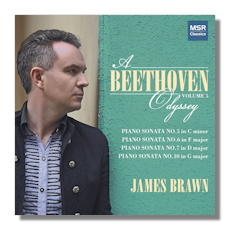
The Internet's Premier Classical Music Source
Related Links
- Beethoven Reviews
- Latest Reviews
- More Reviews
-
By Composer
-
Collections
DVD & Blu-ray
Books
Concert Reviews
Articles/Interviews
Software
Audio
Search Amazon
Recommended Links
Site News
 CD Review
CD Review
Ludwig van Beethoven

A Beethoven Odyssey, Volume 5
- Piano Sonata #5 in C minor, Op. 10, #1:
- Piano Sonata #6 in F major, Op. 10, #2:
- Piano Sonata #7 in D major, Op. 10, #3:
- Piano Sonata #10 in G major, Op. 14, #2
James Brawn, piano
MSR Classics MS1469 71:12
This cycle of the thirty-two Beethoven sonatas by English-born pianist James Brawn on MSR Classics has now pushed past the midpoint with volume 5. He's done twenty thus far, though most of the meatier and bigger sonatas lie ahead. I have noted before that this pianist has the ability to make you hear the music in a different way much of the time. That isn't easy to do in Beethoven's well traversed sonata oeuvre, as you can imagine, but I previously observed what I thought was perhaps his strongest natural gift – his "unerring sense for capturing the mood in the music, whether it be sadness, mischief, humor, tragedy, anxiety, or a mixture of these. He always seems on target." Indeed, and in this group of four works, he once again seems to find the heart of each one. Even listeners strongly accustomed to the interpretations of a favorite pianist in these sonatas should find Brawn's performances to their liking.
He deftly captures the mood shifts in the first movement of #5, both its sober, often anxious busyness and its warm serenity. He makes us feel the lonely and isolated character of the second movement by highlighting its broken sense of flow, its spastic lurches and its final sense of calm and consolation. He nicely contrasts the nervosity and driven character of the Prestissimo finale with its joyful humor by finding the perfect tempo and not making it sound rushed or hectic. Again, throughout this sonata and in the others, Brawn demonstrates his ability to sensitively apply a broad range of dynamics and use rubato subtly and sparingly.
The Beethoven Sixth Sonata is one of my favorites from the composer's early period. Brawn turns in a fine performance, playing up the generally chipper demeanor in the first movement with lively tempos and a lean though not brittle tone. He captures the darker character of the ensuing panel all right but wisely avoids turning ponderous by employing somewhat animated pacing and holding back on the legato. His finale sparkles with arguably the perfect tempo as well as deft accenting and his subtly applied, almost unnoticeable rubato. Compare his account of the finale with Alfred Brendel's on Philips: the latter is somewhat brittle and rushed, while Brawn sounds totally natural with everything flowing nicely to make the shoe a perfect fit. I must mention that I cite Brendel here because he is, despite relatively minor shortcomings, one of the stronger examples of fine Beethoven pianism.
In the Seventh, perhaps the most substantive of the Op. 10 sonatas, Brawn infuses the joy and humor of the opening movement with excitement and an action-packed sense, offering a genuine Presto tempo as his fingers dance athletically to negotiate the challenging rush of notes. His phrasing in the second movement Largo deftly conveys the uncertainty and gloom, while his leisurely pacing and light, springy touch produce a colorful and fully convincing Menuetto. His finale features well judged accents and subtle contrasts in dynamics, the whole coming across with plenty of vigor and spirit.
The Tenth Sonata, again a somewhat light work, gets another fine performance from Brawn, as he demonstrates his ability to show that Beethoven's early music doesn't need an extra measure of weight and angst to be effective. Brawn's finale is a gem as he so playfully captures the start-and-stop manner of much of the writing, as well as those playful upward runs that seem almost to jump right off the page at you.
In sum, once more, Brawn presents the listener with a thoroughly brilliant collection of performances in his ongoing cycle of the Beethoven sonatas. The first three volumes were reviewed here in 2015 (MSR 1465), and the fourth (MSR 1468) later that same year. It appears that Brawn may well end up with a set of these thirty-two works to rank with some of the very best cycles put on record: Barenboim (try his 1980s Euroarts video effort, though his more recent performances are also very good), Brendel (probably the Philips set from the 1970s is best), Buchbinder (C Major video), Schnabel (if you can tolerate the 1930s sound reproduction), Arrau (Decca) and, if you like muscle, Michael Korstick (Oehms). I also found François-Frédéric Guy (Zig Zag) very interesting. Brawn is a pianist to watch and certainly an artist who has something to say in Beethoven. The sound reproduction by MSR Classics is vivid and well balanced. The pianist's album notes are enlightening. Strongly recommended.
Copyright © 2018, Robert Cummings


















